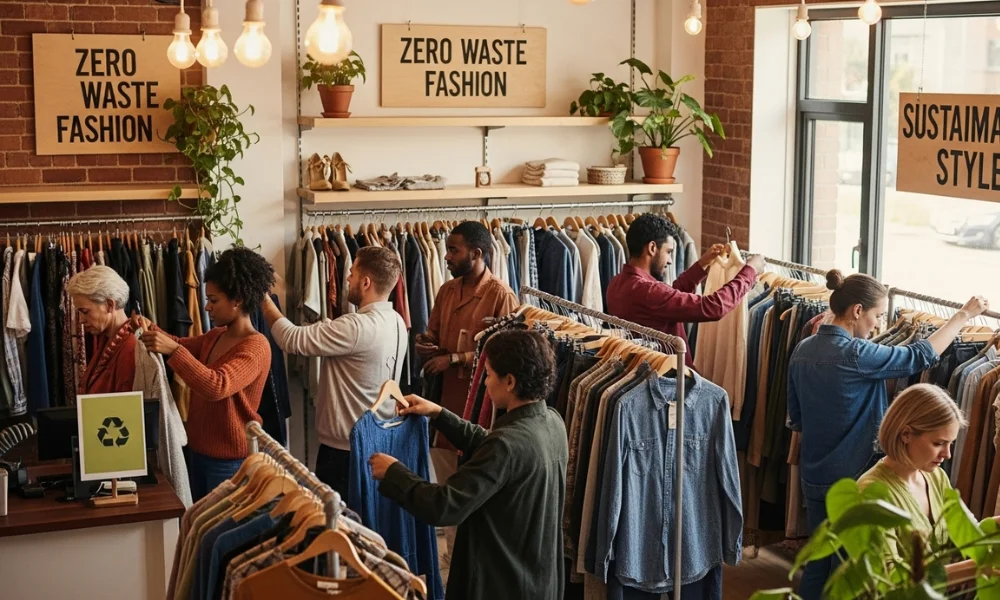Zero waste fashion is a movement that aims to eliminate textile waste completely. It focuses on designing, producing, and consuming clothing in ways that reduce environmental harm. People are drawn to it because it offers practical solutions to fast fashion’s growing waste crisis. In this guide, you’ll learn what zero waste fashion means, how brands apply it, and what you can do to join the movement.
Why Zero Waste Fashion Matters
Zero-waste fashion matters because the global clothing industry produces millions of tons of waste. Most of this waste is in landfills or incinerated, causing massive environmental problems. By adopting zero-waste principles, brands and consumers can cut down on harmful emissions and resource depletion.
What Is Zero Waste Fashion? Approaches & Philosophies

Zero-waste fashion is an approach in which designers aim to create garments with no fabric left over. This includes smarter pattern cutting and reusing leftover materials in new designs. Some brands focus on pre-consumer strategies, while others specialize in post-consumer recycling or upcycling. Together, these methods form a powerful toolkit for reducing textile waste and inspiring a new generation of designers.
Pre-Consumer Zero Waste Fashion
Pre-consumer zero-waste fashion involves reducing waste before a garment reaches stores. Designers use pattern efficiency, modular pieces, or digital sampling to eliminate offcuts. These practices save fabric, reduce costs, and conserve resources from the start. Many forward-thinking brands now prioritize these methods as part of their sustainable fashion goals.
Post-Consumer Zero Waste Fashion
Post-consumer zero-waste fashion addresses waste after clothing has been sold or worn. It focuses on upcycling old garments, repurposing textiles, or reclaiming materials for new products. This approach keeps items out of landfills and supports a circular economy. Consumers can join in by donating, swapping, or creatively reworking their clothes.
Differences, Tradeoffs, and Overlap
Both approaches share the goal of minimizing waste but use different tactics. Pre-consumer strategies rely on technical design skills, while post-consumer solutions often emphasize creativity and reuse. Some brands blend the two, designing zero waste patterns and also offering take-back programs. Understanding these overlaps helps you see the bigger picture of zero waste fashion.
Core Techniques & Principles in Zero Waste Fashion Design
Zero waste fashion design combines art, engineering, and sustainability in exciting ways. Designers use methods like pattern nesting, modular garments, and digital tools to achieve waste-free production. These practices not only help the planet but also open new creative possibilities. Below are key principles and techniques that make zero waste fashion work.
Pattern Layout & Nesting Strategies
Pattern layout is a key technique for arranging fabric pieces to leave no scraps. Designers experiment with shapes, rotations, and repeats to fit everything perfectly. This reduces cost and eliminates offcuts at the production stage. When combined with digital tools, it also speeds up sampling and reduces mistakes.
Modular Garments & Adaptable Designs
Modular garments are designed so parts can be rearranged or replaced. This approach lets consumers refresh a look without buying something completely new. It also extends the life of a garment and reduces wardrobe waste. Many zero-waste clothing brands now experiment with modular or transformable pieces.
Zero Waste Grading for Multiple Sizes
Grading means adjusting patterns for different sizes, which often creates waste. Zero waste grading develops size ranges without changing the core waste-free pattern. This technique saves fabric and supports inclusive sizing. It’s a technical but powerful way to make zero waste fashion more scalable.
Using Deadstock Fabrics and Reclaimed Textiles
Deadstock fabrics are unused or leftover materials from other productions. By using deadstock, designers divert textiles from landfills and cut costs. Reclaimed textiles can also add uniqueness to each garment. This method combines zero waste goals with creative storytelling in fashion.
Upcycling & Repurposing as Design
Upcycling transforms existing garments or materials into higher-value products. Designers and consumers alike can patch, dye, or reshape old clothes into new pieces. This approach celebrates creativity and reduces post-consumer waste. It’s also one of the most accessible zero waste methods for everyday people.
Digital Tools and 3D Sampling
Digital tools like 3D sampling and AI pattern software help minimize waste. They allow designers to test shapes, fit, and fabric use before cutting anything. This saves time, materials, and money while producing more accurate results. Such innovations make zero waste fashion design easier and more efficient.
Zero Waste Fashion Brands & Real-World Examples
Many brands have embraced zero waste fashion to lead by example. They use deadstock fabrics, innovative patterns, or closed-loop systems to cut waste. These pioneers show that sustainability can also be stylish and profitable. Below is a table highlighting some notable zero waste clothing brands:
| Brand | Key Practice | Why It Stands Out |
|---|---|---|
| Tonlé | Uses scrap fabrics for handmade garments | Offers unique, small-batch designs |
| Zero Waste Daniel | Creates clothing entirely from pre-consumer waste | Combines bold style with eco innovation |
| Whimsy + Row | Limited runs with deadstock fabrics | Reduces waste and overproduction |
| Bastet Noir | Custom made-to-order clothing | Eliminates unsold inventory waste |
Brand Practices and Business Models
These brands show how business models can drive zero waste outcomes. Some focus on made-to-order systems, others on modular designs or recycling. By marketing the story behind their materials, they also engage consumers emotionally. This approach builds loyalty while supporting sustainable goals.
How Consumers Can Embrace Zero Waste Fashion

Consumers play a vital role in making zero waste fashion mainstream. Simple shifts in shopping and wardrobe habits can significantly reduce textile waste. Supporting brands, reusing clothing, and mindful buying all make a difference. Here are ways to start adopting zero waste fashion in daily life.
Buying Smart and Supporting Zero Waste Brands
Choose brands that clearly explain their sustainability practices. Look for terms like “zero waste clothing,” “deadstock fabrics,” or “upcycled.” Supporting these businesses helps them scale and influence the wider industry. You also get unique pieces with a positive story behind them.
Shopping Second-Hand, Vintage, or Thrift
Buying second-hand extends the life of garments and keeps them out of landfills. Vintage and thrift shops offer unique finds that align with slow fashion principles. This practice saves money while reducing demand for new production. It’s a simple way to participate in a circular fashion economy.
Upcycling Your Wardrobe
Upcycling your wardrobe can be fun and creative. Patch holes, dye old shirts, or combine pieces into new styles. These small acts reduce waste and give you one-of-a-kind clothes. Even beginners can start with simple projects like turning jeans into shorts.
Repair and Maintenance
Maintaining your clothes helps them last longer and reduces consumption. Learn basic repairs like sewing buttons or fixing seams. Regular care, such as gentle washing, also prolongs fabric life. These habits support a sustainable and zero-waste lifestyle.
Mindful Consumption and Capsule Wardrobes
Mindful consumption means buying less but better. Capsule wardrobes encourage mixing and matching a few versatile pieces. This reduces impulse purchases and overstuffed closets. Over time, you’ll save money while shrinking your fashion footprint.
Challenges, Tradeoffs & Limitations
Despite its benefits, zero-waste fashion faces challenges. Some issues include cost, scalability, and consumer awareness. Addressing these challenges is key to growing the movement. Understanding them also helps you make realistic choices as a designer or consumer.
Scalability and Cost
Zero-waste design often requires more time and skilled labor. This can increase costs and limit availability for mass markets. Brands must balance price, sustainability, and style. Over time, digital tools and demand may lower these barriers.
Aesthetic Constraints and Design Limitations
Working within zero-waste patterns can limit design freedom. Some shapes or styles may be harder to produce waste-free. Designers must think creatively to make garments attractive and functional. This challenge also drives innovation and unique aesthetics.
Supply Chain and Material Access
Sourcing deadstock or reclaimed textiles can be inconsistent. Quality and availability may vary from one season to another. Brands need flexible designs and supply chains to handle this. Collaboration with suppliers and recyclers can help.
Consumer Awareness and Market Demand
Many shoppers still know little about zero-waste fashion. Education and storytelling are essential to changing this. Brands that share transparent practices often build stronger connections. Over time, awareness creates demand and drives systemic change.
Future Trends & Innovations in Zero Waste Fashion

The future of zero-waste fashion is bright and full of innovation. Technology, policy, and changing consumer values all play a role. Staying informed about these trends helps you see where the movement is heading. Here are some exciting developments on the horizon.
AI and Algorithmic Pattern Optimisation
AI can analyse countless pattern layouts to minimise waste. Designers save time and resources by using these smart tools, which makes zero-waste design faster and more scalable. We can expect AI-driven systems to become standard in fashion production.
Advanced Recycling and Biodegradable Fabrics
New recycling methods can turn old clothes back into high-quality fibers. Biodegradable or self-healing fabrics reduce waste even further. These materials support a truly circular fashion model and give consumers more sustainable choices.
Fashion Rental, Subscription, and Resale Models
Rental and resale platforms dramatically extend the life of garments. These models reduce the need for constant new production. They also give consumers affordable access to high-quality pieces. Combined with zero-waste design, they reshape how we consume fashion.
Policy and Regulation Shifts
Governments are starting to address textile waste through regulation. Extended producer responsibility and textile recycling laws are examples. These policies push brands to adopt zero-waste principles. Over time, policy can make sustainable practices the industry norm.
Practical Toolkit & Resources
If you’re ready to try zero-waste fashion, start with a toolkit. Designers can find open-source patterns, while consumers can learn basic repairs. Below are resources and ideas to help you take action today.
-
Checklist for designers: test digital patterns, use deadstock, plan modular pieces
-
Checklist for consumers: buy second-hand, upcycle clothes, repair regularly
-
Recommended tools: 3D sampling software, online sewing tutorials
-
Networks & events: sustainable fashion forums, local sewing groups, zero-waste pattern communities
Conclusion
Zero-waste fashion is more than a trend; it’s a path to a healthier planet. Designers, brands, and consumers all have roles to play in reducing textile waste. You can join this movement by supporting zero-waste brands, shopping smarter, and learning basic skills. Small steps today create a more sustainable and stylish future for everyone.

